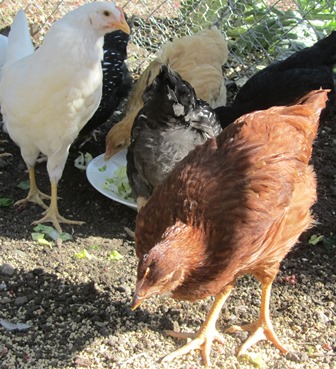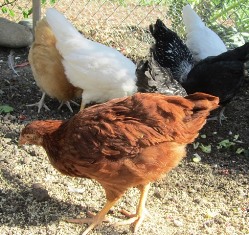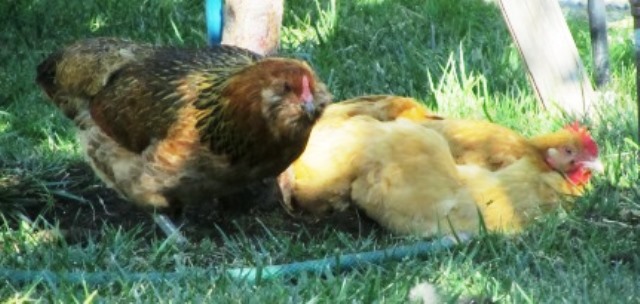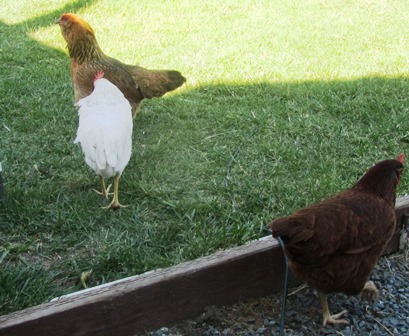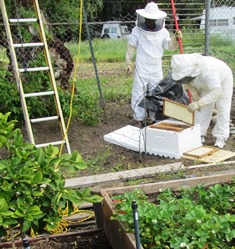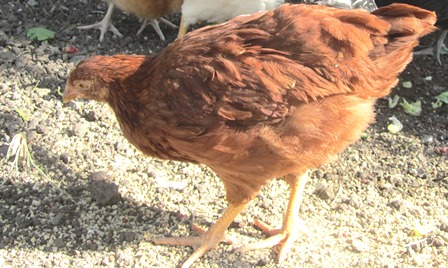Archive for the 'Animals' Category
Resources to Assist Pet Owners in Tough Times
I always learn a lot from my regular visits to the Contra Costa County Animal Shelter. I was surprised to learn that the shelter doesn’t take in just dogs and cats but also chickens, guinea pigs, rabbits, and other animals.

Moose isn’t a shelter animal but a very pampered pet belonging to my daughter’s family–some dogs in Contra Costa County are not so fortunate
But most alarming for me was learning that some people in our current economy are having trouble paying for their pets’ required shots or annual license renewal. Others, for a variety of reasons, may need food for their pets. In tough times, pets can suffer, too.
Thanks to generous donations within Contra Costa County, the shelter is happy to share (when available) the pet food that is donated. That said, the shelter urges all pet owners to have backup plans in case the shelter’s donated supplies are running low.

This little cutie is one at the shelter I fell in love with; I picked out a name, returned to adopt, and someone had already claimed him
If you are a pet owner needing assistance with getting pet food and your Plan A didn’t work out, you might consider the following Plan-B, Plan-C, and Plan-D.
Plan-B: Contra Costa Humane Society Ani-meals Program
Phone: (925) 676-7543 or 1 (800) 870-3663
Plan-C: Tony LaRussa’s ARF Food Relief Program
Phone (925) 256-1273, ext. 463; website: http://www.arf.net/animal-programs/foodshare
The ARF program also helps people in their program with spay and neuter services.
Plan-D: Furry Friends Food Relief Program:
Phone (925) 240-3178; website: http://www.furryfriendsfoodre.wix.com/fffr
If you love animals and would like to help families and their pets who might be struggling, consider donating money, pet food, or your time to your local animal shelter. Shelter staff members and volunteers give phenomenal care to the creatures who cannot fend for themselves.
The shelter will hold the animals for a while or relocate them with rescue organizations or find them temporary foster homes. The best outcome is adoption into a forever family home. In Contra Costa County, people with questions about food distribution programs can call the Humane Education Department at (925)-335-8340.
Protecting Your Backyard Flock in a Heat Wave
I lost a chicken this morning despite taking measures to protect her from the deadly heat wave we’ve been having here in the Bay Area. The last thing someone attached to their hens ever wants to see is one of her precious little girls gone. Mine was a Silver Laced Wyandotte (who leaves behind a sister) and five other hens with whom she was raised.
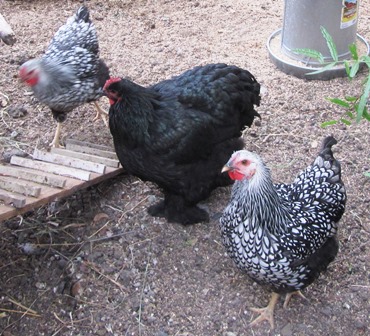
The Silver Laced Wyandotte (black-and-white) hen in the foreground succumbed to the extreme heat sometime during the night
Our farmette sits in the east bay hills and too far inland from the San Francisco Bay or the delta (which flows to Sacramento) to gain much benefit from cooling breezes off the ocean. We’ve had triple digit temps on the farmette for days.
I put out extra water basins for my chickens, kept their doors open in the chicken house at night (there is a wire run with a wire ceiling to protect them when they’d rather roost outside), and fed them frozen corn, cool seedless watermelon treats, and chilled grapes.
The chicken house has windows that I keep open (they have reinforced wire over the screens). I reduced the amount of litter on the floor (I use ground corn cob) since it could hold the heat.
I haven’t install a fogging system or fans, but I might if this heat keeps up.
The only telltale sign that my hen was in trouble was that she seemed to exhibit lethargy and to have lost weight (although it was difficult to tell under all her feathers).
Her comb had turned slightly pale and seemed to have shrunk in the last 24 hours. When I check on her last night she was turning herself to face the wall. Not a good sign since, in my experience, I’ve seen chickens do this before they pass away.
Some strategies for helping backyard chickens survive extreme heat include the following tips.
Eight Strategies to Help Chickens Beat the Heat
1. Make sure windows of chicken houses face north to south to allow breezes to blow through, rather than face east to west (rising and setting sun).
2. Keep litter on the chicken house floor low (1 to 2 inches is sufficient).
3. Position your chicken house under a tree, if possible, where the structure receives shade.
4. Make certain you have several watering dispensers (placed in the shade) with clean, fresh water every day during hot weather.
5. Add ice cubes to the watering canisters.
6. Put out treats such as bowls of frozen corn and cool, seedless watermelon, and chilled grapes or blueberries.
7. Use a fan, if necessary to remove heat from the chicken house.
8. As an emergency measure for a chicken that looks distressed, dip her in cool water.
Update on the Buffo Broodzilla
My Buff Orpington hen, who’d been sitting on a couple dozen infertile eggs for weeks–some rotten and others broken–finally left the nesting box after I removed all the eggs. I’ll be set up for baby chicks next year in my hen house, but not now.
At first, she continued to display her broodzilla behaviors (aggressive, flighty, angry) and was easily set off by the antics of the other chickens. However, within a day or two, she’d normalized her old laying routine and began running with the other hens as they foraged around the farmette, took dust baths, clamored for chicken snacks, and pecked at each other.
My neighbor told me to dunk her in cold water to break her broody cycle. That’s because hens who go broody have an elevated body temp. Removing the eggs worked this time; maybe next time, I’ll try cooling her off. Or . . . if it happens in the spring, I might get some baby chicks and let her raise them.
I’m certain there will be a next time–she’s gone broody three times in a year and half. Some hens have that tendency.
Consider This Before You Get Backyard Chickens
My bedroom window faces the back of our property where the chicken coop sits. Every morning, I’m awakened by repeated grauwkkkk sounds made by the Silver Laced Wyandottes and the Rhode Island Red hens, the noisiest ones of all my chickens.
I wish I’d read up more on the breeds before making my selections at the feed store. I love keeping chickens and the eggs are fabulous. That said, there are some of the areas I wish I’d known more about. I might have chosen different breeds.
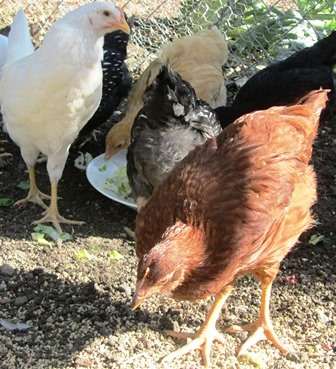
Rhode Island Red hen seems to be at the top of the pecking order in this small flock of backyard chickens
1. Noisemakers–some breeds are noisier than others. I seldom hear the occasional cluck from my White Leghorns, but the Wyandottes never seem to shut up. Get a bunch of hens together and conversing, and you’ll soon see what I mean.
2. Snacking–chickens love snacks but give them judiciously. If they consume too many treats like blueberries, fresh corn from the cob, and bits of bread or rice, the quality of their eggs may suffer. But as soon as you give them treats, they become your best friends and will follow you around.
3. Pecking–chickens quickly establish a pecking order; they will also peck you . . . some harder and more aggressively than others. My Black Sex Link hen just seems kind of mean and pecks with impatience. But the Rhode Island Red will give an almost loving peck that’s not hard and doesn’t hurt.
4. Broodiness–when a hen goes broody (like my Wyandotte and Buff Orpington hens), her hormones have told her she needs to sit on a clutch of eggs until they hatch (about three weeks). But if you do not have a rooster to have fertilized those eggs, the hen will sit on them anyway, tying up a nesting box and hoarding eggs that will have to be tossed out when she finally figures out that she’s engaged in a futile pursuit of baby chicks. Some breeds tend to broodiness more than others.
5. Water and Food–chickens need water, love crumble, and can benefit from a serving of cracked grains and dried worms. To ensure their egg shells are sufficiently rigid, they may also need additional oyster shell calcium. And like all living beings they need fresh water. If they go without water, they can stop laying for weeks. I’ve figured out the cracked grains must be so tasty they are like cotton candy and after them, the hens don’t want their good food.
6. Diminishing Returns–hens begin laying when they are about five months old. After the first year, egg production will fall off about 20 percent in subsequent years. They generally lay eggs for seven or eight years, but can live to be older and produce no eggs.
7. Egg size–when a hen tries to lay too large of an egg, it can cause a condition called cloaca prolapse. It can claim her life–I’ve lost two chickens to this problem. One was an Ameraucana heritage chicken that laid blue-green eggs. I do miss her as she was skittish but quiet.
8. Moving Hens or a Rooster–if you are getting the gift of a chicken from a neighbor or friend, move that chicken into the flock at night. When he or she wakes up in the morning, the whole event will be a fait accompli and will generate less stress for all involved.
Why You Should Never Leave the Farmhouse Door Open
I unlatched the hen house door to let the birds out for the day. Then I filled water basins for my chickens, honeybees, and farmette wildlife. Finally, with chores done, I returned to the farmhouse to work on my new book.
Lost in a tense winter scene for novel number three, I wrote until I heard the chickens cackling as they do when they lay an egg or are frustrated because they can’t get the nesting box already occupied by another hen. And of late, that happens often because one of my Wyandotte chickens has gone broody. She’s sitting on two dozen eggs and it’s futile since we don’t have a rooster. Those eggs will never hatch.
As the cackle grew louder. I stopped typing to peer out the window next to my desk. Nothing seemed out of the ordinary, but on the off chance that a skunk, fox, chicken hawk, or other predator had invaded the yard or the hen house, I got up. I had to check.
By now the cackle had become deafening. I thought the chicken might be at the back door. As I turned from my computer to walk down the hall past my bedroom, I saw my Rhode Island Red directly in my path. Her cackle could wake the dead. So why was she making such a ruckus.
Then I saw it–a dollop of chicken poop on my new hardwood floor. She must have known I’d be furious. And she’d been trying to tell me something. I swooped her up and carried her outside, making a mental note to always check the door on the farmhouse. My office is no place for a chicken.
What’s Eating the Chicken Eggs?
Several times over the last month or so, I’ve traipsed to the hen house to collect eggs and found a broken egg or one with a hole in the shell and the egg otherwise intact.
I wondered if one of the chickens had gone rogue and was pecking the egg that either she or one of the other hens had laid.
My flock is small and they usually lay their eggs during the morning hours, using the afternoon to free range and forage.
Each time I heard a cackle, I sprinted to the chicken house to see who was raising the ruckus and whether or not she’d pecked her egg.
Finally, I caught one of my Silver-Lace Wyandotte hens on the nest. With her head twisted behind and under her wing, I could not tell what was going on. I slipped my hand under her, causing her head to jerk around. It appeared I had caught her in the act as her beak was covered with yolk.
So I thought I’d solved the mystery. My solution was to remove each egg as soon as the hen laid it. If I removed the eggs, any temptation for the chickens to peck the eggs would be eliminated, too. But running for every chicken squawk became so time consuming, I finally stopped.
To my utter surprise, there were no more broken eggs. That didn’t make sense. However, during the whole ordeal with the broken eggs, I’d been smelling a skunk. When my closest neighbor said a skunk had been raiding his coop for the eggs, I began to think I had wrongly accused my poor Wyandotte.
Indeed, since my neighbor took care of the skunk (by trap, I believe), my hens are producing eggs every day and none have holes or are cracked. I’m now thinking the skunk was the egg robber.
That experience got me thinking about other predators that will eat chicken eggs (and chickens, too). The list includes opossums, weasels, rats, snakes, minks, foxes, wild dogs, coyotes, raccoons, hawks, and owls. So, even if I’ve got a nice hen house and a run with a wire roof, it seems that a predator motivated by a good meal with find a way in.
The Prolapsed Vent Issue
It happened to one of my chickens a few years ago; now, it’s happened again.
My one-year-old Ameraucana hen–a blue-egg layer–developed a prolapsed vent from trying to lay a too-large egg. The first time it happened, I did all the things I’ve learned to do: separate her from the flock, reduce light, nutrition, and water (to stop her from trying to lay more eggs).
I used a lukewarm towel to clean her. Latex gloves and vaseline to try to push the vent/cloaca back in. And it worked for a while. It took her a couple of weeks to recover. Elated, I thought she would be fine. Not so.
By the time I realized it had occurred again, the other chickens had been pecking her–drawing blood–and she seemed weak, wobbly, and near death. I repeated the previous steps, thinking she’d pull out of it, but by morning she was gone.
Disheartened, I began to search chicken forums on the Internet to find out which breeds are susceptible to this issue. I learned the Cornish game hens and chickens that are bred for meaty bodies are more likely to have the vent prolapse, but I haven’t yet learned whether or not the Ameraucanas are equally susceptible. If anyone knows, drop me a line. Thanks.
How My Real Life Informs My Art
Every story needs a setting, a world in which something happens. For my cozy mysteries, I didn’t set out to create a new world for my coterie of characters, I just appropriated details of the life I am living as a farmette dweller.
Daily chores on our Henny Penny Farmette provide plenty of fodder for my fictional stories. Our daily activities include chicken care, garden and orchard work, beekeeping, cooking and preservation of vegetables and fruits, renovating the antiquated farm house, fixing sheds, and building fences and retaining walls.
Stories need a sense of verisimilitude for readers to suspend disbelief and join the fictional journey. Drawing upon my real-life experiences, I can easily integrate my adventures in my books. And not only my activities, but also experiences of my architect husband who is ever-occupied with making our old house more liveable.
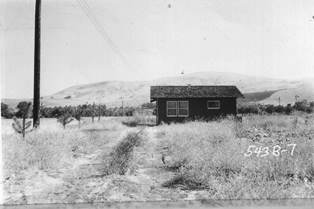
In this 1953 photo, our little house sat in a great, big field with not much around it; the dwelling faced Mount Diablo (still does) and the Delta and great central valley lie to the northeast
The tax assessor told me that our dwelling might have been a mining shack in the late 1940s (we live near Mt. Diablo and Lime Ridge where mining and rock quarrying were once important industries). We’ve also been told that our little house might have later served as a farm home (we live less than two miles from designated agricultural farmland). The structure desperately needed updating when we found it almost five years ago. But as settings go, the house and farmette work great.
We have since used recycled and reclaimed materials, sale items at big box DIY stores, and gifts (like lumber, stone, and windows/doors) from friends who do demolition on estates. We’ve visited companies that sell granite and asked for permission to take broken stone from their dumpsters. Thus, we’ve created a lovely bathroom floor with found materials that we’ve cut and sanded.

Light from a crystal chandelier dances off the new granite counter, but the floors were not yet installed when this photo was taken
Of course, the exact details of our daily activities may not make their way into my stories, but versions of them sometimes do. At the very least, such activities inform my storytelling. I daresay the chickens and bees serve important roles in my mysteries. And each new day brings new adventures, from foxes showing up to skunks and raccoons raiding our fruit and nut trees.
Lately, a new chicken showed up on our property (a heritage chicken that had the ability to fly over my neighbor’s fence). She’s been staying here ever since. Wild turkeys often take a path through the property and once or twice a gorgeous stallion named Romeo and its owner ride by and say hello. Such events can add textural details to the setting of a story.
A Dog-Gone Good Day for Rain

Any rainy day is a good day to nap, even if it is Halloween when there might be spooks roaming around
Happy Halloween from the Henny Penny Farmette. It’s raining at last!
The San Francisco Giants, by winning the World Series, must have created Mojo in the Pacific because the storm door has opened. It’s been raining outside my farmette window for a few hours. Could this spell an end to our extreme drought?
It’s been a quiet day for me working on my second book. The two dogs that I’m caring for have shown me the sweetest doggie affection with their wagging tails, smiles (yes, I think they smile), and lots of licks. They’ve won me, the reluctant dog-sitter, over.
We’ll have to say goodbye today though. Their family is enroute from Disneland and will be home in a couple of hours. So while the dogs and I started off on the wrong paw, overall I’d have to say it was a great adventure. I’m gonna miss them.
Help–There’s a Chicken on My Back
Collecting eggs, I bent over into the chicken house. Suddenly, a large chicken land on my back and start talking to me in her chicken language. I immediately knew it was my Rhode Island Red. She follows me everywhere.
It would have made a cute picture, but here’s the thing: you don’t want chickens tarrying too long in one place because they are famous for frequent and abundant droppings.
The Rhody is the most personable chicken in my flock and the one I handled the least when I cared for the flock of baby chicks in a tub in my kitchen. However, the chicken I handled the most from my tub of baby chicks was the yellow Buff Orpington, and today she’s difficult with the other hens and its also the first to have gone broody.
As I do chores around the farmette, the Rhody keeps me company. When I go inside to work in my office on my writing projects, she often hangs out under my office window, clucking or making an number of various chicken sounds. She also responds to my voice when I call out her. If I had it to do over again, I’d have a whole flock of Rhode Island Reds, just for the personality.
 Facebook
Facebook Goodreads
Goodreads LinkedIn
LinkedIn Meera Lester
Meera Lester Twitter
Twitter






